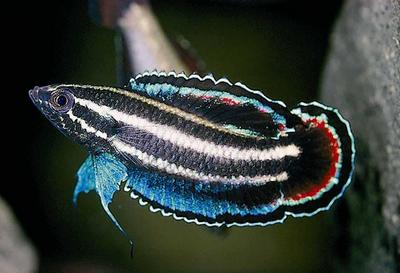Kottelat & Ng 2005
First description: The Raffles Bulletin of Zoology 2005 Supplement No.13: 102 f.
Characteristics: Dorsal structure: XII-XIV, 5-6, total 18-19, anal fin: XI-XIII, 8-10, total 20-22. ♂ in breeding colourwith blue and turquoise ribbons and large black areas in the unpaired fins, additionally with mostly narrow red seams; pelvic fins whitish to blue with medium long filaments. ♀ distinction from other types of harveyi group difficult to impossible. ♀ courtship colouring pale beige to yellowish. While the basic colour pattern is relatively constant, in detail there are still significantly different-colored varieties, which might have originally belonged to separate populations.
Similar species:high, especially with partly mixed blue/red finned species with round caudal fin like rubrimontis, tweediei, opallios. There are conjectures that the close proximity of its area of occurrence to tweediei´s has possibly led to natural hybrids. But since the two species occur on the opposite sides of the Singapore strait this is not very likely without human interference.
Occurrence / Distribution: Western Malaysia, Johore, area of Kota Tinggi, Mawai and Desaru. Originally occuring in peat forest swamps, but today it only exists in its remnants. The species can partly still be found there in streams and brooks or in roadside canals altered by development..
Threat: very high. Large parts of the original range are no longer habitable for the species. Even the former aquarium stocks are almost extinct so the remaining fish deserve renewed attention and breeding efforts.
Discovery/First import:it is likely that the species has been found occasionally since the fifties. Ng et al. collected the holo- and paratypes since 1992. The first description was made in 2005, certainly considerably later than the first appearances of the species in trade.
Trade: the attractive species has obviously been traded repeatedly mainly in the nineties, sometimes in different varieties (see e.g. spec. aff. alfredi “Mimbon 98”) and was bred and distributed in considerable numbers by Hallmann (D). Since then is has occurred significantly less frequent in trade, probably because of the shrinking natural habitats.
Care / Breeding: type locality with black water of pH 4.5 to 5.0. Standard breeding conditions for Paros. After several generations, fertility problems and dwarf growth occurred. The unclear situation of the apparently more or less different local varieties and the temporary trade with blue and red-finned licorice gouramis has most likely led to mixing different varieties even in the aquarium stock.
Behaviour / Particularities: typical licorice gourami of the harveyi-group. Head-down courtship. Very attractive, colourful species.
Literature:
Weblinks: Paros alfredi and its destructed habitat
(PF and DA)


